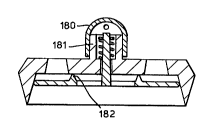Une partie des informations de ce site Web a été fournie par des sources externes. Le gouvernement du Canada n'assume aucune responsabilité concernant la précision, l'actualité ou la fiabilité des informations fournies par les sources externes. Les utilisateurs qui désirent employer cette information devraient consulter directement la source des informations. Le contenu fourni par les sources externes n'est pas assujetti aux exigences sur les langues officielles, la protection des renseignements personnels et l'accessibilité.
L'apparition de différences dans le texte et l'image des Revendications et de l'Abrégé dépend du moment auquel le document est publié. Les textes des Revendications et de l'Abrégé sont affichés :
| (12) Demande de brevet: | (11) CA 2180269 |
|---|---|
| (54) Titre français: | OBTURATEUR POUR TROP-PLEIN |
| (54) Titre anglais: | OVERFLOW PREVENTER |
| Statut: | Morte |
| (51) Classification internationale des brevets (CIB): |
|
|---|---|
| (72) Inventeurs : |
|
| (73) Titulaires : |
|
| (71) Demandeurs : |
|
| (74) Agent: | OYEN WIGGS GREEN & MUTALA |
| (74) Co-agent: | |
| (45) Délivré: | |
| (86) Date de dépôt PCT: | 1995-01-04 |
| (87) Mise à la disponibilité du public: | 1995-07-13 |
| Licence disponible: | S.O. |
| (25) Langue des documents déposés: | Anglais |
| Traité de coopération en matière de brevets (PCT): | Oui |
|---|---|
| (86) Numéro de la demande PCT: | PCT/GB1995/000007 |
| (87) Numéro de publication internationale PCT: | WO1995/018896 |
| (85) Entrée nationale: | 1996-06-28 |
| (30) Données de priorité de la demande: | |||||||||
|---|---|---|---|---|---|---|---|---|---|
|
Ce dispositif pour trop-plein comprend un bouchon logeable dans un trou de vidange et pourvu d'une soupape susceptible de se déplacer d'une première position dans laquelle elle est fermée, vers une seconde position dans laquelle elle est ouverte, cette soupape étant sollicitée souplement vers sa première position lorsque la pression exercée sur elle est inférieure à une valeur prédéterminée.
An overflow preventer comprising a plug receiv-
able in a drain hole and provided with a valve movable
between a first closed position and a second open posi-
tion, the valve being resiliently biased to the first position
while the pressure on the valve is less than a predeter-
mined value.
Note : Les revendications sont présentées dans la langue officielle dans laquelle elles ont été soumises.
Note : Les descriptions sont présentées dans la langue officielle dans laquelle elles ont été soumises.

Pour une meilleure compréhension de l'état de la demande ou brevet qui figure sur cette page, la rubrique Mise en garde , et les descriptions de Brevet , États administratifs , Taxes périodiques et Historique des paiements devraient être consultées.
| Titre | Date |
|---|---|
| Date de délivrance prévu | Non disponible |
| (86) Date de dépôt PCT | 1995-01-04 |
| (87) Date de publication PCT | 1995-07-13 |
| (85) Entrée nationale | 1996-06-28 |
| Demande morte | 2003-01-06 |
| Date d'abandonnement | Raison | Reinstatement Date |
|---|---|---|
| 1999-01-04 | Taxe périodique sur la demande impayée | 1999-08-09 |
| 2000-01-04 | Taxe périodique sur la demande impayée | 2000-01-07 |
| 2002-01-04 | Taxe périodique sur la demande impayée | |
| 2002-01-04 | Absence de requête d'examen |
| Type de taxes | Anniversaire | Échéance | Montant payé | Date payée |
|---|---|---|---|---|
| Le dépôt d'une demande de brevet | 0,00 $ | 1996-06-28 | ||
| Taxe de maintien en état - Demande - nouvelle loi | 2 | 1997-01-06 | 50,00 $ | 1996-11-29 |
| Taxe de maintien en état - Demande - nouvelle loi | 3 | 1998-01-05 | 50,00 $ | 1997-12-10 |
| Rétablissement: taxe de maintien en état non-payées pour la demande | 200,00 $ | 1999-08-09 | ||
| Taxe de maintien en état - Demande - nouvelle loi | 4 | 1999-01-04 | 50,00 $ | 1999-08-09 |
| Rétablissement: taxe de maintien en état non-payées pour la demande | 200,00 $ | 2000-01-07 | ||
| Taxe de maintien en état - Demande - nouvelle loi | 5 | 2000-01-04 | 75,00 $ | 2000-01-07 |
| Taxe de maintien en état - Demande - nouvelle loi | 6 | 2001-01-04 | 75,00 $ | 2000-12-20 |
Les titulaires actuels et antérieures au dossier sont affichés en ordre alphabétique.
| Titulaires actuels au dossier |
|---|
| BLANEY, TREVOR |
| Titulaires antérieures au dossier |
|---|
| S.O. |